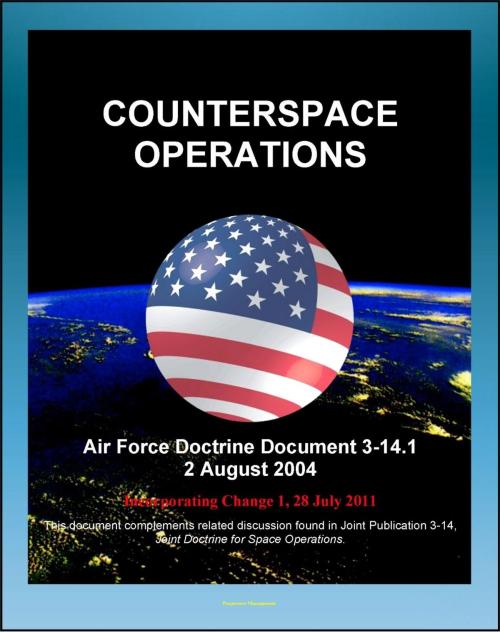Air Force Doctrine Document 3-14.1: Counterspace Operations - Space Situation Awareness, Surveillance, Reconnaissance, Targeting, ISR, GPS, Space Order of Battle
Nonfiction, Science & Nature, Technology, Aeronautics & Astronautics, Science, Physics, Astrophysics & Space Science| Author: | Progressive Management | ISBN: | 9781476303178 |
| Publisher: | Progressive Management | Publication: | April 16, 2012 |
| Imprint: | Smashwords Edition | Language: | English |
| Author: | Progressive Management |
| ISBN: | 9781476303178 |
| Publisher: | Progressive Management |
| Publication: | April 16, 2012 |
| Imprint: | Smashwords Edition |
| Language: | English |
Counterspace operations are critical to success in modern warfare. The rapid maturation of space capabilities and the evolution of contingency operations have greatly enhanced the effectiveness of air and space power. Combatant commanders leverage space capabilities such as communication; position, navigation, and timing; missile warning; environmental sensing; and reconnaissance to maintain a combat advantage over our adversaries. As demonstrated by the Iraqi deployment of global positioning system (GPS) jammers during Operation IRAQI FREEDOM, adversaries will target space capabilities in an attempt to deny that combat advantage. We must also be prepared to deprive an adversary of the benefits of space capabilities when American interests and lives are at stake. Space superiority ensures the freedom to operate in the space medium while denying the same to an adversary and, like air superiority, cannot be taken for granted. The development of offensive counterspace capabilities provides combatant commanders with new tools for counterspace operations. Air Force doctrine, likewise, is evolving to reflect technical and operational innovations. Air Force Doctrine Document (AFDD) 2-2.1, the Air Force's first doctrine publication on counterspace operations, provides operational guidance in the use of air and space power to ensure space superiority.
Space superiority is gained and maintained through counterspace operations which is one of the Air Force's air and space power functions. Counterspace operations have defensive and offensive elements, both of which depend on robust space situation awareness. These operations may be utilized throughout the spectrum of conflict and may achieve a variety of effects from temporary denial to complete destruction of the adversary's space capability.
This publication codifies United States Air Force (USAF) beliefs and practices on the use of counterspace operations in planning and executing military operations. It is useful to the tactician, operational-level planner, and strategist in formulating and carrying out an effective plan for defending United States (US) access to space and denying hostile exploitation of that medium.
Contents: Chapter One - Counterspace Operations * Chapter Two - Command And Control Of Counterspace Operations * Chapter Three - Space Situation Awareness * Chapter Four - Defensive Counterspace Operations * Chapter Five - Offensive Counterspace Operations * Chapter Six - Planning And Executing Counterspace Operations
Topics covered include space situation awareness (SSA), center of gravity (COG), surveillance, reconnaissance, targeting, C3 and C4 ISR, GPS, the Blue, Red, and Gray space order of battle, deception, disruption, denial, degradation, and destruction.
Counterspace operations are critical to success in modern warfare. The rapid maturation of space capabilities and the evolution of contingency operations have greatly enhanced the effectiveness of air and space power. Combatant commanders leverage space capabilities such as communication; position, navigation, and timing; missile warning; environmental sensing; and reconnaissance to maintain a combat advantage over our adversaries. As demonstrated by the Iraqi deployment of global positioning system (GPS) jammers during Operation IRAQI FREEDOM, adversaries will target space capabilities in an attempt to deny that combat advantage. We must also be prepared to deprive an adversary of the benefits of space capabilities when American interests and lives are at stake. Space superiority ensures the freedom to operate in the space medium while denying the same to an adversary and, like air superiority, cannot be taken for granted. The development of offensive counterspace capabilities provides combatant commanders with new tools for counterspace operations. Air Force doctrine, likewise, is evolving to reflect technical and operational innovations. Air Force Doctrine Document (AFDD) 2-2.1, the Air Force's first doctrine publication on counterspace operations, provides operational guidance in the use of air and space power to ensure space superiority.
Space superiority is gained and maintained through counterspace operations which is one of the Air Force's air and space power functions. Counterspace operations have defensive and offensive elements, both of which depend on robust space situation awareness. These operations may be utilized throughout the spectrum of conflict and may achieve a variety of effects from temporary denial to complete destruction of the adversary's space capability.
This publication codifies United States Air Force (USAF) beliefs and practices on the use of counterspace operations in planning and executing military operations. It is useful to the tactician, operational-level planner, and strategist in formulating and carrying out an effective plan for defending United States (US) access to space and denying hostile exploitation of that medium.
Contents: Chapter One - Counterspace Operations * Chapter Two - Command And Control Of Counterspace Operations * Chapter Three - Space Situation Awareness * Chapter Four - Defensive Counterspace Operations * Chapter Five - Offensive Counterspace Operations * Chapter Six - Planning And Executing Counterspace Operations
Topics covered include space situation awareness (SSA), center of gravity (COG), surveillance, reconnaissance, targeting, C3 and C4 ISR, GPS, the Blue, Red, and Gray space order of battle, deception, disruption, denial, degradation, and destruction.















